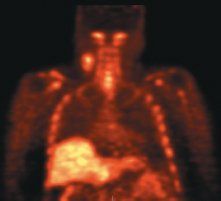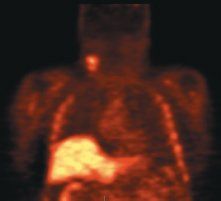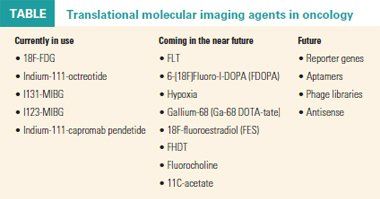H&N imaging gains new radiotracers
PET paired with a variety of radiotracers offers insights into the metabolic, DNA, and protein pathways.
ABSTRACT: PET paired with a variety of radiotracers offers insights into the metabolic, DNA, and protein pathways.

Imaging is too often looked at as an afterthought rather than an integral part of clinical cancer trials, according to Michael M. Graham, MD, PhD, president of SNM, the molecular imaging society.
"Imaging has to be built in at the front end because it's relatively expensive," Dr. Graham told a roomful of radiation oncologists. "If you get a trial going, get the funding, and then go talk to your nuclear medicine person and ask for PET images, he's going to tell you that each image will cost around $1,500. They don't like to give those scans away. But if you ask from the start, you can build those costs into the budget."
And it would be a worthwhile expenditure, as metabolic imaging can truly advance the diagnosis, staging, and response assessment, said Dr. Graham, who is also the director of nuclear medicine and a professor of radiology at the University of Iowa in Iowa City.
At the 2010 ASTRO Multidisciplinary Head and Neck Cancers Symposium in Chandler, Ariz., Dr. Graham outlined the three areas where metabolic imaging is up and coming for head and neck cancers: metabolism, hypoxia, and receptors.

Metabolism
There are a number of molecular imaging agents that can be used to view metabolic pathways of cancer, with 18F-fluorodeoxyglucose (FDG) leading the pack. FDG measures glycolysis, and the radiotracer has proven itself many times over in head and neck cancer.
Dr. Graham cited a meta-analysis of FDG-PET and FDG-PET/CT in head and neck cancer, which found that the molecular modalities had an accuracy of 91% to 98% for the detection of lymph node metastases compared with CT (60% to 90% accuracy). In addition, PET imaging changed patient management in 30% to 57% of the cases (J Clin Oncol online, August 20, 2009).
Another glucose analog, 2-[N-(7-nitrobenz-2-oxa-1,3-diaxol-4-yl)amino]-2-deoxyglucose (2-NBDG), has interesting possibilities, Dr. Graham said. This fluorescent agent was recently used successfully as a topical agent in ex vivo tissue and could be useful for surgeons to pinpoint malignant tissue. "It's an example of imaging that is not necessarily nuclear or radioactive," he said (Int J Cancer 124:2634-2642, 2009).
Other metabolism-measuring agents that home in on tumor metabolism are 3'-deoxy-3'-[18F]-fluorothymidine (FLT), which measures DNA synthesis; 1-[11C]-acetate for lipid synthesis; and amino acids for protein synthesis.
11C -acetate "is a simple molecule that gets into a lot of metabolic pathways," Dr. Graham explained. "In tumors, it gets primarily into the lipid synthesis pathway and its uptake in tumors is a marker of lipid synthesis. It has turned out to be particularly useful in prostate cancer."
A study out of Umea University Hospital in Sweden used 11C-acetate PET imaging (ACE-PET) for staging head and neck cancer and found that it was as good as, if not better than, FDG at detecting lesions (Eur J Nucl Med Mol Imaging 34:651-657, 2007).
"But before you run out and ask your nuclear medicine people to start doing 11C-acetate imaging, you want to recognize that 11C-acetate has a half-life of 20 minutes. Also, it's made on a cyclotron and you have to have the synthesis equipment ready to go. It's not the simplest [agent to produce], but it may be an interesting approach," he said.
For DNA synthesis, FLT is a radiotracer to watch. Korean investigators used FLT-PET before and after treatment with gefitinib (Iressa) in patients with advanced adenocarcinoma of the lung. They reported that pretreatment standard uptake value (SUVmax) of the tumors did not differ between responders and nonresponders to treatment. At seven days after initiation of therapy, the percent changes in SUVmax were significantly different between the two groups (Clin Cancer Res 14:7423-7429, 2008).
In head and neck cancer, FLT-PET could be used to identify how much marrow has been suppressed after radiotherapy (see Figure). In a study done by Dr. Graham's group at the University of Iowa, the FLT uptake and change early after treatment in squamous head and neck tumors was adequately characterized with SUV obtained at 45 to 60 minutes and correlated well with other post-treatment markers (J Nucl Med 50:1028-1035, 2009).
"If [these early response assessment results] hold up, this is a very powerful concept for a wide variety of therapies, not just EGFR inhibitors, but any chemotherapy agent that is ultimately going to affect the DNA," Dr. Graham said.


Top, baseline FLT-PET scan showing radiotracer uptake in right neck nodes and normal distribution of FLT in the bone marrow and liver. Follow-up FLT-PET scan (Bottom and Top Of Article) after 10 Gy of radiotherapy and one cycle of chemotherapy. The uptake in the right neck nodes is decreased. There is also complete disappearance of FLT uptake in the irradiated bone marrow in the cervical spine consistent with marked reduction of cellular proliferation. Images courtesy of Yusuf Menda, MD, and the Universtiy of Iowa department of radiology.
Finally, radiotracers that measure protein synthesis can indicate how well a tumor is doing, particularly secretory tumors, Dr. Graham said. Imaging amino acids is one area where FDG does not work well in the head and neck, so the hunt is on for other agents.
Belgian researchers tested l-methyl [11C]-methionine-PET (MET-PET) in head and neck squamous cell carcinoma. Unfortunately, MET-PET did not offer better information than CT scans (Radiother Oncol 71:267-273, 2004).
Dr. Graham pointed out that in this study, there was a fair amount of uptake in the salivary glands, making it difficult to differentiate tumor from the submandibular gland. "My thought is that it may be useful in adenocystic carcinomas and mucinous carcinomas, but it's probably not the agent we are going to want to use in squamous cell carcinoma," he said.
Hypoxia
Hypoxia imaging can identify sites for boost radiation, stratify tumors for hypoxic radiosensitizers, and evaluate reoxygenation strategies. Radiotracers to image hypoxia include [18F]-fluoromisonidazole (FMISO) and [18F]-fluoroazomycinarabinofuranoside (FAZA).
Hypoxia imaging is of major interest in radiation therapy, Dr. Graham said. "The key point is that hypoxic tumors are approximately three times more radioresistant than normoxic tumors."
The mechanism of hypoxia imaging with FMISO or FAZA is two-electron reduction, he said. "What happens normally is that an agent gets into a cell and, if [the cell] is normoxic, there is a continuing cycle of reduction and oxidizing. In that case, [the agent] winds up as a neutral molecule that can drift in and out of the cell," he said.
But if the tumor is hypoxic, "[the agent] will undergo an additional level of reduction and turn into a reactive molecule that binds to nearby macromolecules. Hypoxic tissues are ischemic and hypoperfused, so you have to allow a significant amount of time for it to get into tissue," Dr. Graham said.
FACT Imaging drug resistance
Professor Catharine M. L. West
and colleagues at the University of Manchester, UK, offers a list of PET probes for visualizing the mechanisms of drug resistance (
Nat Rev Cancer
4:457-469, 2004).
A study from the Shantou University Medical College-Cancer Hospital in Shantou, China, evaluated the changes in tumor hypoxia on intensity-modulated radiotherapy (IMRT) dose-painting treatment planning with FMISO-PET. IMRT plans to treat head and neck cancer were designed on the basis of one FMISO scan to deliver a boost dose of 14 Gy to the hypoxic volume along with the 70 Gy prescription dose.
The same plans were then applied to hypoxic volumes from a second FMISO scan and the efficacy of dose-painting was evaluated by assessing coverage of the hypoxic volumes. The authors reported that "changes in spatial distribution of tumor hypoxia, as detected in serial FMISO-PET imaging, compromised the coverage of hypoxic tumor volumes achievable by dose-painting IMRT. However, dose painting always increased the [equivalent uniform dose] of the hypoxic volumes" (Int J Radiat Oncol Biol Phys 70:1219-1228, 2008).
Receptors
Currently available radiotracers for imaging tumor-specific receptors include metaiodobenzylguanidine (MIBG), indium-111-capromab pendetide (ProstaScint), and indium-111-octreotide (Octrescan). The latter holds the most promise for head and neck imaging, Dr. Graham said.
A study out of the Netherlands compared imaging with octreotide-labeled somatostatin receptor scintigraphy (SRS) with MIBG scintigraphy and with conventional imaging (MRI, CT) in patients with head and neck paragangliomas. They reported that SRS was superior to MIBG for paragangliomas and is also very useful in detection of metastatic carcinoid tumors (J Nucl Med 49:1232-1237, 2008).

Data courtesy of Dr. Graham.
Then there are peptides, which have proven useful either as carriers of chemotherapeutic drugs and toxic molecules or as radioactive tracers for noninvasive diagnosis and therapy. Researchers at the University of Heidelberg in Germany identified and characterized peptides with an affinity for head and neck squamous cell carcinoma. They concluded that an HBP-1 peptide sequence showed promise as a tumor-binding molecule. "It has the extraordinary feature of being linear but relatively stable, compared with other linear peptides," they stated (J Nucl Med 50:426-434, 2009).
Dr. Graham stressed that the radiotracers he highlighted are just some of many under development (see Table). "This is hardly the end of the story," he said. "There are probably about 200 different agents that are under investigation and I think imaging with these agents is going to be huge, particularly as we advance the concept of personalized medicine."
Newsletter
Stay up to date on recent advances in the multidisciplinary approach to cancer.